
![]()

|
|
|
|
|
|
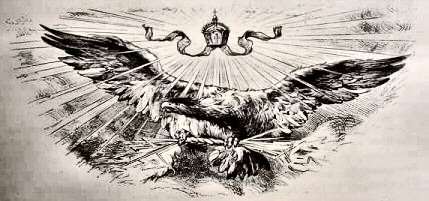

Porcelain and Glass
Page 3
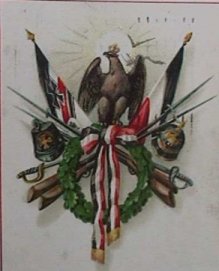
Please be sure to visit our Kaiser Wilhelm II collection.
|
||||||||
|
Beautiful Cup and Saucer depicting the Iron Cross (Item KGLASS 3-1) |
||||||||
| DESCRIPTION: Here is a nice little piece of Germanic culture and refinement. It is a gorgeous cup and saucer by a Bavarian company named Königl. Priv. Tettau. We believe the abbreviation “Königl.” stands for Königlishes and would indicate the possibility that this set had been intended for Royal usage. Another indication of its special treatment are the numbers under the glaze on the edge, and its good stamping. In any case, the two pieces are quite striking an appearance with the golden laurel wreath all around the subjects. Especially interesting is the crowned empire eagle that forms part of the handle. Exquisite!
PRICE: SOLD |
|
||
|
Commemorative Plate of the Hussar Regiment Pommersches Nr. 5 (Item KGLASS 3-2) |
||
| DESCRIPTION: This famed Hussar Regt. was named KGL Königslische Prussian Hussar Rgt. Fürst (Prince) Blucher von Wahlstaat Pommersches Nr.5 named after Marshal Blucher the man who led many a daring charge. History records that the most important one was when he and his “children” Prussian Hussars” tore headlong into Napoleon’s troops at Waterloo and saved Wellington. They brought about the victory and saved the day for the “Iron Duke” who would have lost, and lost totally, without the famed “Marshal Vorwärts” (marshal forward) as his troops named him. The dish depicts a skeleton reposing with his smile of death and under this are the words in Latin “VINCERE AVT MORI,” which translated means “Conquer or die.” This fits in with the leering skull worn by Hussars ever since 1758. the symbolism always connected with elite troops which numbered also the Third Reich SS troops who carried this meaning with the display of the death's head (Totenkopf). Actually, special regiments worldwide use the skull as a reminder of death or glory including the 17th and 21st Lancers of the British Army (the charge of the Light Brigade, Britain's elite cavalry unit). The plate measures 9 1/2 inches in diameter and is in beautiful, perfect shape. There are no nicks or scratches. This is a macabre yet great-looking item of the glory days of European militarism.
PRICE: $298.00: Special reduction; now only $225.00 |
|
|||||||||||
|
Art Plate Commemorating Marine Infantry Regiment No. 1 (Item KGLASS 3-3; WWI 10-9; KRIEG 8-2) |
|||||||||||
| DESCRIPTION: This is a really beautiful porcelain plate or dish that is from the marine infantry detachments under the Kaiser's Kriegsmarine (Kaiserlichmarine). This is for Regiment Number One, the elite of the fighting troops of the navy. These were the man who armed themselves like army personnel, who would do all that was needed to be done when it came to nonshipboard action like clearing beachheads and wiping out enemy artillery nests and communications installations. They were tough and resourceful and a necessary unit to back up successful naval maneuvers. Plate is in good condition and rare.
PRICE: $225.00 |
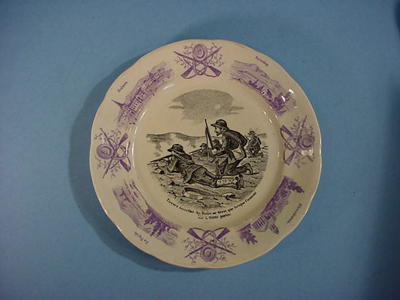 |
A Commemorative Plate from the Boer War Made in France in the 30’s (KGLASS 3-5) |
|||||
DESCRIPTION: The Boer Wars 1880-1881 and 1899-1902. The first was called the Transvaal War and was a relatively brief conflict in which Boer settlers known as Voortrekkers successfully resisted a British attempt to annex the Transvaal and re-establish an independent Republic. This conflict was remarkable for its British- Boer casualty a ratio of 10:1. in favor of the Boers.
The second Boer War by contrast, was a lengthy war involving large numbers of troops from many British possession, which ended with the conversion of the Boer Republics into British Colonies, with a promise of limited self government. These colonies later formed part of the Union of South Africa. The Boers were basically Germanic farmers who had a rigid love of freedom and independence and wanted to be out from under the thumb of the greed motivated, cruel British government and much like the Americans of 1776. "Break away." The British wanted to hold on mostly because of the vast Transvaal pockets of gold!
The British under the old viscious tyrant Lord Kitchner carried on a scorched earth policy of destroying Boer farms and moving civilian into the “first concentration camps” where tens of thousands of women and children died of disease and malnutrition. The war known as the last British Imperial war ( Ha! Ha!) was the longest (almost three years, the most expensive, over two hundred million pounds) and the most disastrous of all wars for Britain between 1815 and 1914. This was just another horrible chapter in the horrid history of the greatest of the rouge nations of the world against innocents.
Kitchener and Roberts no doubt are still walking the “hot coals” down there!
The plate shows Boer combatants as they ambush the Brits. We cannot interpret the writing underneath this but around the edges are the cities of the Boers with rifles and South African hats in a display. The plate is about 7 ¼ inches in diameter. It has a surface crack on the back but it is not going any further. It is 100% stable. The crack is not really a crack ! It is in the glaze You cannot feel it. PRICE: $75.00 |
|||||
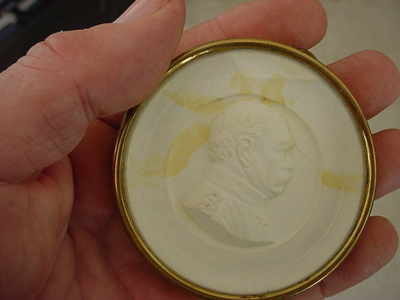 |
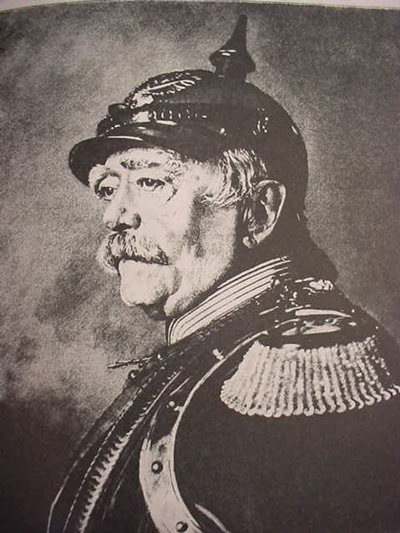 |
A Miniature Bust Relief of the Iron Chancellor, Prinz Otto Von Bismark (Item KGLASS 3-6) |
|
DESCRIPTION: This is a handsome little miniature in porcelain material nicely framed of the German Chancellor under the reign of Wilhelm the 1st, Prussian King and Emperor of all Germany. We won’t go into the history of this energetic, brilliant statesman but at this point, we will highly recommend that you go into Google and write in "Otto Von Bismark Quotes!" They are most inspiring and often humorous. This man was an intense alpha male, probably the greatest and strongest of all European personalities of his time. Each and every quote found there is worthy of genius in my mind. One of my favorites is: “There is a Providence that protects idiots, children and the United States of America.” Also, “When you want to fool the world, tell the truth.” Or, “The more I know of men, the more I love my dog.” And, “To retain respect for sausages and laws, one must not watch them in the making.”And my favorite of all: “Wenn die Deutschen Zusammen halten, so schlagen sie den Tuefuel aus der Holle!” (Translation: “When the Germans act in unity, even the devil shakes in Hell!” Read more about this giant of war and politics, a fascinating personality indeed. The plaque in its frame has about a 3" diameter and is in good shape after probably 90 to 100 years, except the cloth at the back is slightly deteriorated and there are some slight stains on the porcelain or it may be in the inner glass? It is really a museum piece and historically important. PRICE: $145.00 |
|
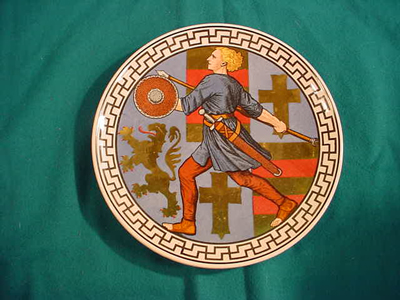 |
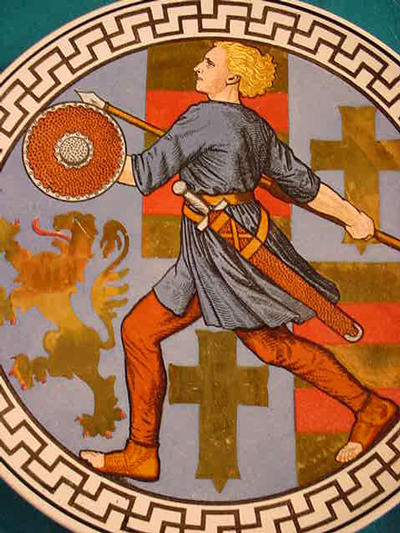 |
A Beautiful Mettlach Plate from the War Year 1916 (?) (Item KGLASS 3-7) |
DESCRIPTION: This depicting a Nordic warrior and rampant lion and there are other smybols also such as crosses and a stack of colors all around the edges. Now see a Greek key design this is truly a fine piece of the porcelain art. It is by the famed manufacturer Mettlach or Villeroy & Boch on the back is their mark plus made in Germany. This country of manufacture was the standard stamp on all the Mettlach products in that time since about 65% of their items were for export but certainly this plate would not be exported to Britain or America in 1916. The stamp would not have been changed however. The words Kriegsjahr 1916 is written in large letter on the back (War Year of 1916). The plate is of a standard commemorative size 9 ¼ inches diameter. We believe it represents the young men of the fatherland going forth to battle the Allies. We also believe it to be hand painted and then fired (possibly unique!). PRICE: $650.00 Most likely worth much more. |
 |
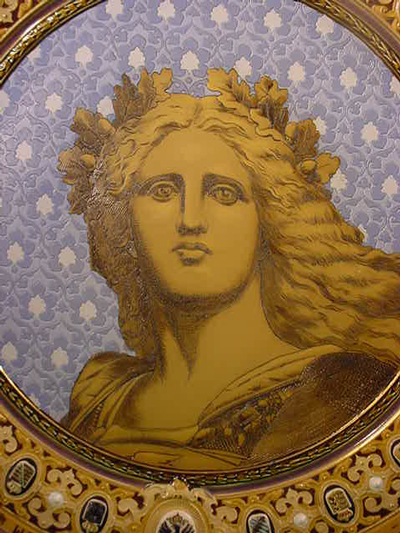 |
Germania International, LLC Presents a Mettlach Charger Depicting Germania (Item KGLASS 3-8 & ART 16-11) |
DESCRIPTION: Here is an item that although it is not that expensive, it is practically precious to our hearts. “Germania” (even the name) inculcates a feeling of extreme pride and glory that can only be felt by a true Germanophile! Her beauty, her noble expression, her proud defiance and regal stature all join in a beholder's celebration of what it is to be a proud German or an ardent admirer of all things Teutonic. The monument was constructed to commemorate the foundation of the Geman Empire after the end of Franco-Prussian War. The first stone was laid on September 16, 1871 by Wilhelm I. The sculptor was Johannes Schilling, and the architect was Karl Weisbach. The total cost of the work is estimated at one million gold marks. It was inaugurated on September 28, 1883. The 38 meter tall monument represents the unity of all Germans. The structure...The central figure is the 10.5 meter tall Germania figure. In the sculptured impression, Germania holds the recovered crown of the emperor in the right hand and in the left the imperial sword. Beneath Germania is a large relief that shows emperor Wilhelm I riding a horse with the Prussian nobility, the army commanders and soldiers. The relief has the Wacht am Rhein (Watch on the Rhine) lyrics engraved upon it. On the left side of the monument is located the peace statue. The war statue is located on the right. The momunent’s main inscription is engraved in the pedestal where the Germania statue is located. “ZUM ANDENKEN AN DIE EINMUETHIGE SIEGREICHE ERHEBUNG DES DEUTSCHEN VOLKES UND AN DIE WIEDERAUFRICHTUNG DES DEUTSCHEN REICHES 1870- 1871." These words..."In memory of the unamimous victorious uprisings of the German People and of the reinstitution of the German Empire 1870- 1871" are the same words as used on the plaque we offer here. The original idea was by sculptor Johannes Schilling. To commemorate the victory of the united German People, but it also admonishes the German people to be vigilant against the arch enemy, France. She faces France and this placement was purposeful as an act of defiance. We have visited her on numerous occasions. Once when I went there on sort of a pilgrimage I was appalled to see that some bastards had put graffiti all over the base. I remarked to one of the attendants that in other “better times” in Germany, the ‘artists’ would have been duly arrested and made to remove their stinking grafitti with a toothbrush and should be in ‘protective custody’ until the cleanup was successfully concluded. If the graffiti was Communist or Leftist inspired, then a rope and the nearest tree might be a good place to dispense justice (Authoritarian? Nationalistic? Yes, emphatically so! Germanophile? Absolutely!) This statue is the personification of nationalistic German pride and it still exists today although the German nation is betrayed by liberals and Leftist goons. “Kommt Der Tage Der Rache!” Okay, anyway "a thing of beauty is a joy forever" and both the actual statue of Germania (Niederwalddenkmal) and this plaque are both gorgeous to my way of thinking and as a true Germanophile I’m sure you will agree. The charger is large --19 ½ inches in diameter. Around the edges are the "Wappen" or Coats of Arms of the various German districts that were now united into a cohesive nation “Der Deutsche Vaterland ” at the bottom is the Prussian eagle representative for the head State of the unification. And all around are the historic words of “Enigkeit” (unity) from 1871 when Wilhelm I presided over the defeat of France and the formation of Deutchland. At one point it says Zum Andenken – ‘Memory of --- Yes dear collector the plaque or charger is certainly a memory of the days of Glory and Majesty. Germania’s face says it all! The charger was produced by the Villory and Boch Company who used the title Mettlach on their beautiful stone wear chargers and plaques. This piece was produced in the golden age of stein production between 1885 and 1916. The name Mettlach is synonymous with quality and value. The most noteworthy innovation of Mettlach during this period was the introduction of what we call today etched steins and plaques. The term “etched” derives from the look and feel of the decoration where the outline and details of the design are formed by incised black lines. These lines can easily be felt by fingertip or fingernail. The design was made from colored clips of clay, which are separated and given detail by the incised lines. These lines were actually formed by mold and no ‘etching’ of the surface was actually involved. The artistic merit and constant high quality of Mettlach, makes it known worldwide and today their products are the best and most sought after in decorative stone worldwide when it comes to stein collecting. Many these were produced -- elves, hunting scenes, soldiers, castles, tavern scenes and many designs feature the “Muchner Kindl” or “prunch child” but above all the varied designs the practically ‘sacred’ one was this depicition of Germania; it had a limited production and we believe this was a decision of the company to keep her pure and not to be sold and scattered over all of Germany in souvenir shops. So, she was seldom carried in authorized Mettlach outlets and she was expensive in those years. To find one today is truly a great find and the collector who buy it can consider themselves very fortunate. PRICE: SOLD |
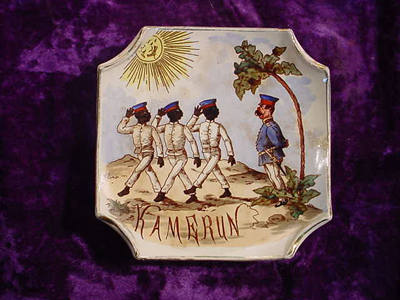 |
Souvenir Dish from German “Kamerun”
(Cameroon) By Mustershutz (Item KGLASS 3-8a & GERCOL 1-2) |
DESCRIPTION: Musterschutz means patent protected and is seen
on various important pieces of German porcelain and
pottery pieces this one is possibly by Villeroy and Boch
(Mettlach!). It is rather humorous as 3 darkie soldiers
who are actually enlisted in the German army march past
their white German officer. Kamerun or Cameroon was
a German Protectorate in West Africa. The Imperial
German Government made substantial investments in the
infrastructure of Cameroon and the lot of the natives were
100% improved after 1884 when it became a German
Colony. The black troops were called Askaris but the
officers of the Schutztruppe or security troops were always
white. The most famous of the German commanders was
of course Paul Emil von Lettow- Vorbeck who led his PRICE: SOLD |
 |
 |
Meissen Commemorative Plate from the Prussian Royal Grenadier Regt III (Item KGLASS 3-10) |
|
DESCRIPTION: This is a beautiful Meissen plate with the seal of the famed Prussian Grenadier regiment No. 3. Around the edges of the plate is the famed saying of Field Marshal and later Reich's President Paul Von Hindenburg. He uttered these noble words on March 25th, 1922. “Die Treue is Das Mark Der Ehre ( Loyalty is the Mark of Honor). On the inside ring are the dates that this elite Regiment served the Fatherland 1864-1866, 1870-71 and 1914–1918. On the back you can see the familiar crossed swords of the Meissen porcelain company. The plate is in perfect condition and is a beautiful historically important piece from the world’s most famous porcelain manufacturer. PRICE: $295.00 |
|
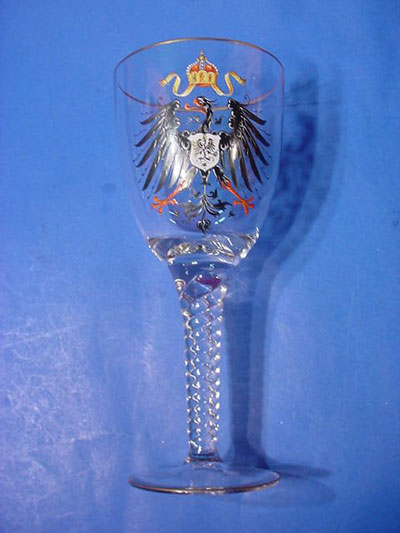 |
Bavarian Imperial Beer Glass (Item KGLASS 3-11) |
DESCRIPTION: This is a very handsome Pilsner glass. Just looking at it makes me have beautiful dreams of drinking a nice full glass like this one of Weissenbier- wheat beer and I am sure that this particular glass from back in the 1920’s was designed for that particular nectar of the Gods! Beer “Delicious Beer” is found in all the southern regions of the Fatherland but especially in Munich. The glass has what seems to be a hand painted double eagle with crown. This two headed bird was used by the Emperor Barbarosa & Emperor Joseph the 2nd and was first used as the arms of the Holy Roman Empire under Karl the Great (Charlemaigne) and it was the symbol of course of the famed German confederation. Actually Bavaria used it all the way up to the unification of the German States under Wilhelm 1st when he proclaimed the German empire in 1871. Then all the then unified states used the single headed National Reich’s eagle and that was used until the Hoheitsabzeichen (The eagle and swastika) was officially adopted as the symbol of the Third Reich in 1935. This beautiful glass measures 13 inches high with a mouth opening of 3 ¼ inches, The base is decorated (painted?) with the Bavarian Lion and checked shield plus wheat sheaths and hops. The gilding about the top rim is intact just as it is on the base -- we just can’t get over the sheer beauty of this one and the fact that it was created to contain that wonderful Weissenbier makes it all the more delightful. A great looking Teutonic treasure. PRICE: SOLD |
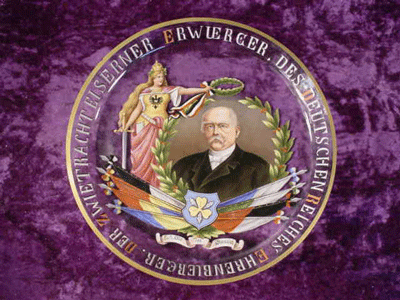 |
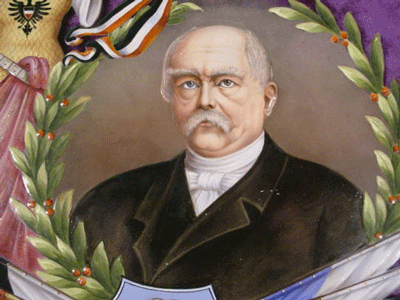 |
Absolutely Beautiful Hand Painted Commemorative Plate Depicting the Glory of Prince Otto von Bismarck (Item KGLASS 3-12) |
DESCRIPTION: This is stunningly beautiful plate depicting the famed Iron Chancellor of Germany receiving the laurel wreath of Victory from Germania the Spirit of Teutonic Germany. The Bismarck family crest of a three leaf clover is seen in a shield with flags that display the unified flags of the German states that he did so much to unify. Along the edges are the words Der Zwietracht Eiserner Erwverger Des Deutschen Reiches Ehrenberger. This refers to the Prince as the champion of German unity and he is described as his nation’s honorary citizen. The plate is 9 ½ inches in diameter and the Bismarck figure & the depiction of Germania are applied over clear crystal glass, to at least my artistic appreciation it is breathtakingly gorgeous!!! But then I am an incurable romantic and a consummate Germanophile personified! Deutschland Über Alles - Über alles in der Welt! PRICE: $375.00 |
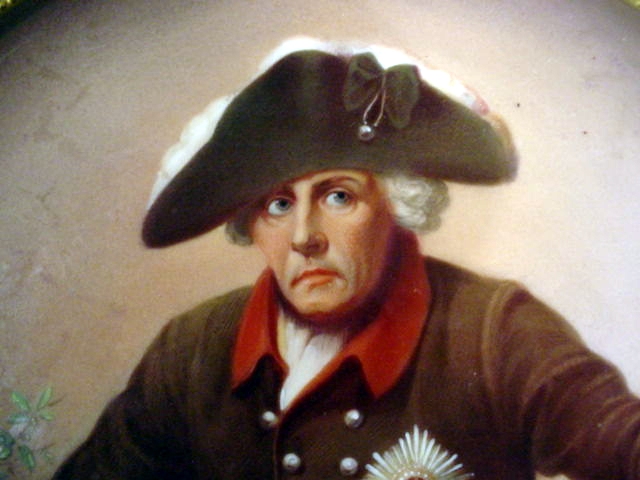 |
A High Art, Commemorative Plate Depicting Frederick the Great
(Item KGLASS 3-13 and FRED 4-5) |
DESCRIPTION: Here is an absolutely stunning depiction of Friedrich II, King of Prussia also known as “Der Alte Fritz.” See the many articles concerning this Grosse König in our Frederick section of the site. We won’t go into the illustrious history of this phenomenal individual since the web is heavy with stories and historical events dealing with him, and we also have some capsule reviews on our pages at Frederick the Great. The plate is 10 ¼ inches in diameter, and all the floral decor is 18th-century design around the edges, and is in highly up-cast overlay that you can feel as your fingers slide across it. I believe genuine liquid gold was employed in the construction. All of the design looks much like the Rococo décor at Frederick’s summer palace at Sans Souci in Potsdam. ( Absolutely gorgeous!) The mark on the back is the scepter of the KPM company of Berlin (Konigliche Porzellan Manufaktur) (The Royal Porcelain Manufacturer). Under that mark is a depiction of a lamb that has Dresden, Germany, and the numerals 135. This indicates that the retailer was this particular company who handled KPM masterpieces such as this. Also, there is the king’s title written out under the glaze. For important historical treasures of German porcelain and high art, this is certainly the epitome! PRICE: $1,500.00 |
|
||||
|
Novel Military Schnapps Flask (Item KGLASS 3-14; WWI 12-13) |
||||
| DESCRIPTION: This is a beautiful piece of pressed or cut glass. It is a Schnapps flask carried by a German officer in WW I. It is beautifully constructed with precise glass engraving showing the Iron Cross 1st Class surrounded by boughs of oak leaves and surmounted with the Royal Prussian Crown. The beautiful translucent wine color is spectacular. On the backside you can see a gorgeous deeply cut, many-pointed-star depiction. The flask has a diameter of about 6 inches. The neck is also decorated with leaf design and would have carried a simple cork stopper. This flask, I am sure, provided some small pleasure for a superior officer of the Kaiser when at rest in regimental quarters.
Zum Wohl! Oder Prost!
PRICE: SOLD |
|
|||||
|
Porcelain Business Card Holder (Item KGLASS 3-15) |
|||||
| DESCRIPTION: This is a wonderful, rare porcelain tray that we believe is a receptacle for business cards, or it could be a repository for one’s pocket items upon the day’s retirement such as coins, jewelry, glasses, etc. In any case, it reflects the spirit of the times with the proud German eagle as the central theme. The eagle clutches the Iron Cross and this indicates to us that the item was produced for patriots or military personal. There is an inscription on the front that says Adolf Beer and Company in Nuremberg on the Karolinen Strasse #30. On the backside of the item is the signature of the porcelain company that produced it: Glas. Porzellan Haus Küchengeräte Wirtshaft Einrichtungen. It measures 7 inches across and 4 ½ inches wide and is of a hard-paste porcelain. It has a slight stain in the front-left corner where some GI probably used it as an ashtray and slightly burned it with a Lucky Strike. This is a priceless gem with a price!!!
PRICE: $650.00 Expensive? No,- - - Priceless! |
|
||||||||||||||||||||||
|
Seven Villeroy & Boch Mettlach Plates Depicting German Soldiers (Item KGLASS 3-16; KSTEIN 2-12) |
||||||||||||||||||||||
| DESCRIPTION: Here is a fantastic grouping of plates by the famed Villeroy & Boch firm located in Mettlach, Germany. This is the revered manufacturer of the finest of ceramics and porcelain. Collectors please note the similarity between the Mettlach military theme beer steins (the series) and note that these plates are virtually identical in color and style. Although the stein series is rare, it is found much more often than the plate series. They are truly scarce even in the professional circles of Mettlach collectors.
Ever since they were first produced in about 1850 Mettlach steins and chargers, plates, and other ceramic items have been cherished as very-high-quality art objects. The group of seven plates we have to offer according to the man we bought them from has provided us with the following information. He said his mother-in-law, Elizabeth Keller, gave him the plates in 1966 and at the time told him that her mother, Elizabeth Bernhard, was working as a truly loved and highly appreciated servant at the baronial estate of Count von Helldorf in Wiesbaden, Germany. Elizabeth Bernhard received the plates from Count v. Helldorf as a wedding present when she married August Enders on July 6, 1901, in Wiesbaden. Interesting is the possibility that this count von Hellddorf of Wiesbaden may very well be the father or grandfather of Wolf Heinrich Graf von Helldorf, president of the police in Potsdam and Berlin. Born a nobleman’s son in Merseburg, he was a member of the Reichstag 1933-1944. Unfortunately, he was involved in the 1944 plot to kill Adolf Hitler and was executed by hanging in 1944 at Plotzensee Prison. We cannot definitely attest to the relationship, but it looks very possible. I hope the elder Graf von Helldorf fared better and was a true German patriot. The Plates There are seven of them all in perfect condition. Only one of them features the full Mettlach markings with the winged angel face hovering over the Villeroy & Boch geared logo. The rest of them have numbers and letters example (737 Geschutz and a large F, A, K, J, etc.) but anybody can see that they all are from the same Mettlach series. Each one depicts a different epoch of German military history and each has an individual title running over half the front diameter and each soldier is identified below the image. They are depicted in periods from the time of Frederick the First to the Franco-Prussian War of the 1870s, and here they stop since they were presented as the wedding gift in 1901; so they date well before the First World War. They are well over 100 years old and to still be in this condition is remarkable, but goes to prove my earlier statement about being cherished! These are a worthy treasure to grace any good collection of Mettlach steins or a notable Imperial German collection. PRICE: $1,225.00; that’s about $175 each for plates that individually could sell for about $350 each, or more. Serious collectors should move quickly on these! We are offering these magnificent pieces at a very special discount. All for $880.00. |
|
||||||
|
Pair of Imperial Enameled Cordial Glasses (Item KGLASS 3-17) |
||||||
| DESCRIPTION: Here is a very handsome set of glasses probably made for the headquarters building of the Deutsches Reich Kriegsdienste (Correct me if I am wrong!). Nevertheless, there was such an organization and it was a medical-aid group and this one was branch 16811 in Hamburg. It served the North Sea and Atlantic and was often life-savers for first aid to ships of the line, sailors who had been injured in warfare, or even civil ventures. It was sort of the St. Bernard of the sea and many the sailor owed his life to these men and women who were dedicated to their humane services. The glasses were obviously made with high-precision-art handling and the enameled colors and design are spectacular. The anchor depicts its field of operations and the caduceus represents its medical mission. The “25” on the anchor we believe represents its 25th anniversary and the glasses were probably specially produced for the celebration. They are quite beautiful and the sincere patriotism is quite evident as the schwartz, weiss, rot banner is evident running around the circumference of each glass. Note the fine, 24K-gold-plated rim around the lip of the glass and the heavy base at the bottom. “Would those glasses be made like that today?” They are 7 ¼ inches high with a 2 ½-inch-diameter opening at their mouths. They just don’t come finer or more reasonably priced.
PRICE: $285.00 for the pair. Don’t miss it! |
|
|
|
Beautiful German WWI Period Smoking Pipe (Item KGLASS 3-18; KMISC 2-5; WILHELM 9-19) |
|
DESCRIPTION: Here is a smaller version of the gigantically long commemorative pipes that were purchased in the 1870s to the beginning of WWI by graduating students from regimental academies and such. They are invariably beautiful and were costly, even in their day. The new officer candidates were very proud of these beautiful memory objects from their service time. This one is particularly spiffy in that is has the depiction of Kaiser Wilhelm II as its central theme on the pipe bowl surrounded by raised oak leaves and acorns tied together by a bow at the bottom. The cap on the bowl is reminiscent of a stylized German spike helmet. The stem is of hand-carved bone or horn (elaborately carved). The tip of the stem is of a material that freely bends mounted over a spring that is quite flexible. When laid out straight the whole piece measures 2 feet long. The pipe bowl itself is about 5 inches tall and about 2 inches wide. This is really a gorgeous item and reminds one of the glories of the Hohenzollern Reich at its peak.
PRICE: $285.00; a very modest price |
|
|
Utterly Magnificent Crystal Goblet Featuring Crests of German Nobility (Item KGLASS 3-19) |
|
DESCRIPTION: This has to be the finest lead-crystal vase goblet we have ever seen; even in museums. It is very large—16 inches tall—with a top mouth opening a full 6 inches in diameter. It has a 24-karat gold rim and a stemware pedestal precisely cut in diamond-shaped fissures or notches that enable a tight grip for the person handling the goblet. The incredible aspect that stands out most beautifully is four noble German family coats of arms that are etched by hand into the glass. Definitely, this lost art saw its end in this magnificent form and example prior to the First World War. The Germans, especially in Prussia, were the leading advocates of this extraordinary art form. The pattern is similar to the finest Irish Waterford crystal stemware, but in our estimation, even finer! The etching is done in the highest artistic excellence possible, and I am sure that it would not be much rivaled by any comparable museum pieces or in the finest collections. If I may repeat myself and say again that this is without a doubt utterly magnificent! When a finger is softly flicked against the upper rim you will hear a beautiful soft yet fairly audible and gorgeous-sounding chime that absolutely sounds like the night bells at the Berlin Cathedral. This of course is always an important test of the very finest of crystal glass. The coats of arms are beautifully etched or cut in such a way that when your finger would touch them they stand right out there and are completely responsive to the touch. You could practically recognize them in braille. The families represented are as follows: Von Moltke aus Prussia Graf zu Castell-Rüdenhausen-Bavaria Von Ketteler aus Westphalia Von Böcklin aus Schaffhausen Surely, the most famous of the families represented would be the family von Moltke. This was a noble family resident in Prussia originally from Mecklenburg. Members of the family have been noted as statesmen and great military leaders in the German wars. The family is descended from Fredericas Meltiko, a knight of Mecklenburg who lived in the mid 13th century. We believe the goblet was possibly commissioned by the von Moltke family; the most illustrious and noteworthy member being Helmuth von Moltke the Elder (1800-1891), Chief of the Prussian and then German General staff. He commanded the Prussian armies in the Franco-Prussian War 1870-1871. He was regarded as the creator of the new, more modern method of directing armies in the field. He is often referred to as Moltke the Elder to distinguish him from his nephew, Johann Ludwig von Moltke, who commanded the German army at the outbreak of WWI. Helmuth von Moltke the Younger (1848-1916) was born in Biendorf, Grand Dutchy of Mecklenburg-Schwerin, and was named after his uncle the General Field Marshal and hero of the unification of Germany. During the Franco-Prussian War, Moltke served with the 7th Grenadier Regt. and was cited for bravery. He had a brilliant, illustrious career and in 1918, he became deputy chief of the general staff. He was closer to the Kaiser than all the other candidates. Moltke’s tight friendship with Kaiser Wilhelm permitted him latitude that others couldn’t have enjoyed. It was often said that the Kaiser’s moustache was in itself a “declaration of war.” Then it should be also said that the Moltke family’s favorite planet was indeed Mars. We have shown one version of the von Moltke’s family crest. Note: The three gamecocks and seven helmet feathers say they were clearly one of the most illustrious and aristocratic families of all of Prussia and Germany. The second family crest to the left of von Moltke’s is of the Castell kindred. In this case, the listing is for Graf Count Castell-Rüdenhausen. The counts of Castell were a noble family of mediatized counts of the Holy Roman Empire and as such, rank with the reigning dynasties of Europe. The heads of the two reigning branches are Castell and Castell-Rüdenhausen. The latter’s coat of arms is shown on the goblet and is the only one showing a crown due to their royal lineage and were granted the hereditary title of “princes” by Luitpold Prince Regent of Bavaria. The crown seen is the royal crown of Bayern (Bavaria). The next coat of arms is that of von Ketteler. This is the name of a noble German family of Westphalia. Gotthard Ketteler raised the family to prominence during the Livonian War when he was the Grand Master of the Teutonic Order and master of the Livonian Order. The family was formed in the 15th century. The next crest is for the family von Böcklin. However, we could not find the von Böcklin crest on the web even though it is the prettiest of all the crests that are featured on the goblet. The von Böcklin family had originally descended from an old family of Schaffhausen. We looked up the name von Böcklin and found a famous artist of that name who was descended from that Schaffhausen line. His name is Arnold Böcklin and he was a master of depicting ancient mythology and symbolism such as his famed “Isle of the Dead” and “The Island of Life.” It may well be that the von Moltke family thought so much of the Böcklin paintings that the family crest was included in the design of the goblet. Nazi Propaganda Minister Joseph Goebbels considered Böcklin’s “Play of the Waves” painted in 1883 his favorite work of art and it had been said that the German art world considered it one of the greatest artistic achievements of the century. The von Böcklin crest as seen on the goblet employs a knight’s helmet with two rampant “Bock.” surrounded by foliage. The German word for goat is “bock” and this takes us to “Bock” in Böcklin and the name obviously emerges through extrapolation. So, with all four names of these landed gentry and indeed royal linage it looms obvious that this goblet is obviously stunningly beautiful, but also exceedingly important historically. This has been one of Germania’s greatest finds. We wish to pass it on to the fortunate collector or historian that will be the proud custodian of this gorgeous treasure of Western art. PRICE: $1,950.00 |
|
||
|
Commemorative War Plate (Item KGLASS 3-20; RED CROSS 1-27; WWI 13-19) |
||
| DESCRIPTION: This is a beautiful collector’s plate by the famed porcelain firm Rosenthal in Selb, Bavaria. It commemorates the Red Cross’ participation in WWI by Germany and Austria. The main message printed upon it is “Zur Erinnerung an grosse Zeit 1915.” This translates to “In Memory of the Great Era 1915.” The illustration on the obverse of the plate is noted to be from Prof. L. v. Zumbrusch. The shields that the child bears are the heraldic arms of Germany on the left and Imperial Austria on the right. The flag behind the little lad bears the international insignia of the Red Cross, and on the back it refers to the Prussian Roten Kreuz (Red Cross) and across from this is mentioned the Patriotic Women’s Organization of Austria. Across the reverse is a patriotic quote by Ludwig Fulda. The condition of the plate is perfect and it measures 8½ inches in diameter. It has an unusual fine, brownish-hue finish. We believe it to be a New Year’s commemorative plate given as thankful gifts to Red Cross personnel who had served at the Front. The infant figure probably represents the New War Year of 1915 coming in with a spirit of hopefulness for victory and peace resulting from the Great War.
PRICE: $190.00 |
|
|
|
|
Cut-Crystal Glass of the SMS (Seiner Majestät Schiff) Kaiserin Augusta (Item KGLASS 3-21) |
|
DESCRIPTION:What a gorgeous commemoration piece of glassware this is! Kaiserin Augusta was a unique “protected cruiser,” built for the German Kaiserliche Marine (Imperial Navy) in the early 1890s. (A protected cruiser is a type of cruising warship of the late-19th century and gained their description because an armored deck offered protection for vital machine spaces from fragments caused by shells exploding above them.) She was named for Empress Augusta Marie Luise Katharina (September 1811–January 1890). She was Queen of Prussia and the first German Empress as the wife of Wilhelm I, German Emperor. The ship’s keel was laid down in 1890, launched in January 1892, and completed in November of that year. Kaiserin Augusta served abroad between 1897 and 1902, primarily in the East Asia Squadron. During this time, the ship's crew assisted in the suppression of the Boxer Uprising in 1900. She was declared obsolete in the early 1900s and went into drydock to undergo a complete modernization beginning in 1903, but when this refit was completed in 1905, she was put in reserve. Out the outbreak of WWI, Kaiserin Augusta was put back into service and used as a gunnery training ship. After the war, she went the way of old, retired admirals and warrant officers and was formally stricken from the acive naval register. On 1 October 1919, she was sold to a shipyard and broken up the following year. This is the very finest of cut crystal displaying the ship with “S.M.S. Kaiserin Augusta” etched on the side and the year “1892.” It’s an impressive 11 inches high by 4 inches at the mouth. It has the most melodic ringtone I have ever heard on a piece of crystal when struck, which bespeaks of its fine elegance in craftmanship. This is truly a wonderful antiquity of a noble time in German Imperial history.
PRICE: $495.00 |
Page Three |
|
|
|
Please refer to item designator in parentheses in all correspondence.
Please E-mail for any additional information you may need.